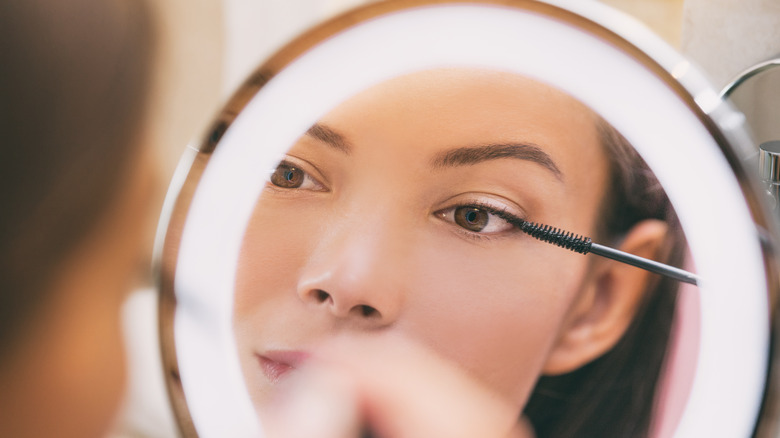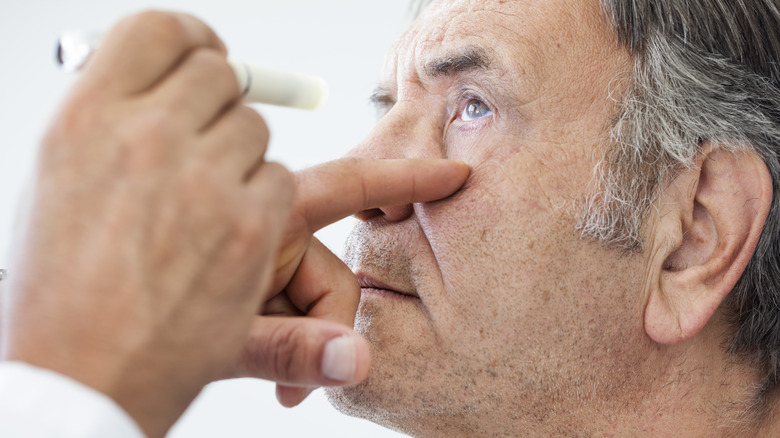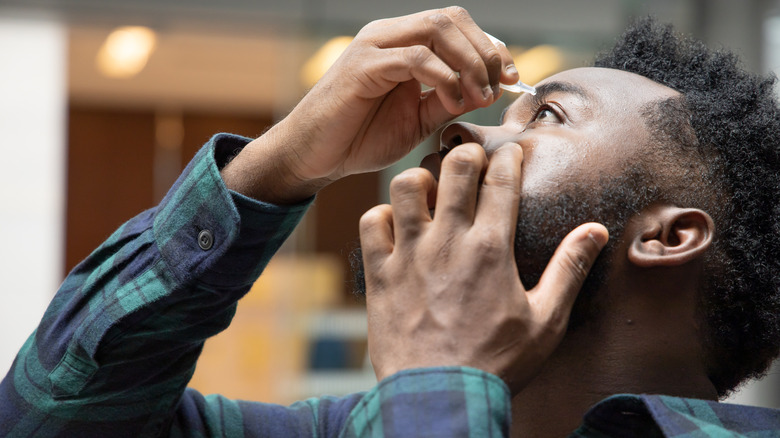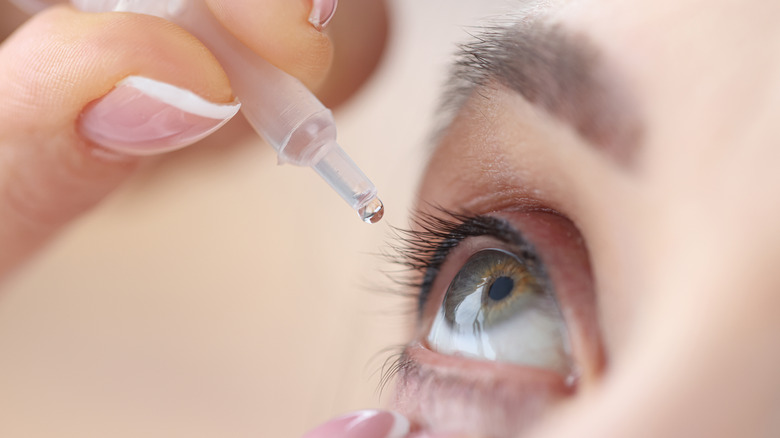Pink Eye Explained: Causes, Symptoms, And Treatments
There are probably only a few who are unfamiliar with the distinct yet common condition known as pink eye. In fact, if you are searching for articles such as these, there's a chance you may currently be dealing with pink eye yourself. Perhaps you woke up this morning feeling some itchy irritation in one eye, or your little one appeared with a swollen, red eyelid. Or, alternatively, maybe you received a letter or email from your child's school notifying you of a recent outbreak of pink eye in their class. While a discovery such as this could initially be alarming, a fundamental understanding of potential causes and treatment options for pink eye can help you feel equipped and prepared to adequately manage the condition.
The Mayo Clinic defines conjunctivitis (the medical term for pink eye) as "an inflammation or infection of the transparent membrane (conjunctiva) that lines your eyelid and covers the white part of your eyeball." Pink eye can occur in newborns, children, and adults and can manifest through a number of potential signs and symptoms, depending on the severity and source of the infection.
While there are various triggers that can lead to this infection, you can rest assured that, in most cases, pink eye is a mild condition. Still, you should be aware of the various causes, symptoms, and treatments.
Cause: Viruses
One of the potential and more likely root causes of your rosy conjunctiva is a virus. There are numerous viruses that can result in pink eye, such herpesviruses or rubella virus, according to the Centers for Disease Control and Prevention (CDC). However, viral pink eye has been found to most commonly be associated with adenovirus. In addition, the virus that causes COVID-19, SARS-CoV-2, has also been shown to sometimes cause pink eye (via Mayo Clinic).
Viruses that can result in conjunctivitis can also cause other conditions, according to the CDC. Mononucleosis, or mono, can occur in those with Epstein-Barr virus, and chickenpox and shingles can occur as a result of the Varicella-zoster virus. In these cases, patients can develop and display symptoms associated with these conditions in addition to conjunctivitis, which can help pinpoint the exact virus at play. For example, if you are experiencing a fever, rash, and cough in addition to your conjunctivitis, you may have specifically contracted rubella virus, which causes measles. However, if you have a pink eye and are experiencing a fever and sore throat, the root cause may be pharyngoconjunctivial fever.
Cause: Bacteria
Bacterial pink eye can also be caused by different types of bacteria and through various forms of contraction. Some of the common bacteria that can cause pink eye include staphylococcus aureus and streptococcus pneumonia, according to the CDC. While most cases are usually mild and resolve within a week or so, conjunctivitis can sometimes be more severe if caused by other particular types of bacteria, such as Neisseria meningitidis or Neisseria gonorrhoeae. If a case of pink eye is suspected to be caused by bacteria, the type, severity, and length of time symptoms are present can help determine which particular bacteria may be the culprit of the infection.
Bacteria-induced pink eye can be acute (most common), hyperacute (rare and severe), or chronic (lasting around 4 weeks), the CDC detailed. Bacterial pink eye can also include chlamydial and gonococcal, both of which can occur in infants and sexually-active people. In both adults and infants, chlamydial conjunctivitis is caused by the bacteria Chlamydia trachomatis. However, about half of infants who have pneumonia have a history of this form of conjunctivitis (via CDC). Gonococcal conjunctivitis is also caused by the same bacteria (Neisseria gonorrhoeae) in both infants and adults, but can be more serious in very young infants and less common in adults.
Cause: Allergens
Another potential reason you woke up with a reddish eyeball could be allergies. In contrast to bacterial or viral conjunctivitis, allergy-related pink eye is a result of environmental irritants. One can also experience an allergic reaction manifesting in pink eye from other sources such as ingredients found products used on the face and eyes (via CDC). It's because of this that pink eye resulting from allergies is not contagious.
Allergy-induced conjunctivitis can also be a result of allergens that arise either seasonally or any time of year, according to Johns Hopkins Medicine. Triggers present in nature or in the air, such as dust and pollen, are usually the culprits of these kinds of allergic reactions. These types of allergens will also typically be more prevalent during the spring, summer, and fall months. Unfortunately, though, there are other allergens that can cause conjunctivitis that are present all year, such as animal fur and mold.
Cause: Irritants
Because our eyes are so sensitive and encounter countless foreign substances on a daily basis, there are also plenty of other things beyond viruses, bacteria, and allergens that can cause pink eye. Particles in the air, such as dust and smoke, can certainly cause eye irritation, which anyone who has ever been to a bonfire or cleaned out an old attic can confirm. However there are other, perhaps less obvious things we come into regular contact with that can also potentially result in conjunctivitis, such as makeup, contact lenses, and various chemicals, according to the CDC.
If you are someone who keeps and occasionally comes back to makeup you've had for months or even years, you risk getting pink eye. This is because while products like mascara don't inherently carry bacteria, they do pick up the bacteria naturally present on our eyelashes (via University of Rochester Medical Center). Initially, this would not cause any issues, but over time as this bacteria continues to build on the mascara wand, which is then housed in a sealed bottle, it can cause irritation to the eyes (via Self).
In addition to bacteria-caked eye makeup, contacts can also be the culprit of your pink eye. In addition to your eyes not agreeing with the chemical makeup of your contact solution, which would be more of an allergic reaction, contacts can also become contaminated if not cleaned properly or worn for too long, per the CDC.
Common symptoms
If you have a routine case of pink eye, you may experience some uncomfortable albeit mild symptoms. "The normal variety of nonaggressive pink eye doesn't feel that bad," Dr. Gene Kim, associate professor of ophthalmology and visual science with McGovern Medical School at UTHealth, told Health. "It's more annoying than it is painful."
One of the more obvious, telltale signs of pink eye is a rosy coloring to the whites of the eyes and sometimes eyelids. This coloration is caused by the blood vessels in the eyes becoming inflamed and therefore more visible, according to the Mayo Clinic. The eyelids may also swell (via Cleveland Clinic).
Other common symptoms you may experience with pink eye are irritation and discharge. Irritation can include itching, burning, and mild light sensitivity. Secretion or discharge from the infected eye can be thick or thin, which can sometimes form a layer of crust around the eyes overnight. The thickness of the discharge can also be indicative of the specific origin of the infection (via Cleveland Clinic).
Symptoms can vary based on the cause
While there are common symptoms that accompany conjunctivitis, there are also other symptoms that are more specific to the source of the infection. For this reason, paying attention to the presence of any of these symptoms can help indicate the origin and therefore most effective treatment.
Viral and bacterial pink eye each have their own distinctly different symptoms. Bacteria-induced pink eye will sometimes also cause an ear infection as well as thick discharge, and more of a reddish coloring to the whites of the eyes (via Cleveland Clinic). A virus is usually the cause of pink eye in adults and can cause a more salmon-red color in the eyes. In this case, one may experience watery discharge, as well as the infection spreading to the other eye (via CDC).
Allergens and irritants can also have more distinct manifestations. Like viral conjunctivitis, if allergens are to blame for your condition, both eyes will also likely be affected. You may also experience more itching and tearing in both eyes, as well as other symptoms commonly associated with allergies such as a runny nose and sneezing (via CDC). If an irritant like smoke or dust is the cause of the infection, you will most likely experience watering of the eyes.
Pink eye can be contagious
Pink eye can be contagious depending on the source, but not in all cases. If the infection is bacterial or viral in nature, pink eye is very easily spreadable. However, contagiousness fluctuates throughout the course of the infection, with bacterial pink eye being most contagious while you are symptomatic and viral pink eye being more contagious sometimes before symptoms even begin (via Cleveland Clinic).
There are different ways by which conjunctivitis can be contracted, either directly from person to person, or indirectly through items that have come into contact with an individual's infected eye. In addition, conjunctivitis can spread through droplets in the air produced by the breath, according to the CDC. Pink eye can also be picked up by touching your eyes after touching a contaminated surface, or by using a product that has come into contact with an infected person's eye, such as makeup (via CDC).
Diagnosis
Because pink eye can be very contagious, it is important to diagnose early to prevent or minimize spread, especially in densely populated settings like schools. One of the ways you may be able to identify the cause of your infection is by looking at recent life factors — consider those with whom you have been in close contact lately and in what capacity. Also think about any new medications you may have recently started taking or products that come into contact with your eyes, like contacts and cosmetics — especially if they are more than a few months old.
Your doctor will be able to diagnose conjunctivitis as well as its cause. Usually, this will involve a visual examination of your eye and assessment of your symptoms (via Cleveland Clinic). Depending on the suspected cause and severity of your case, your provider may take a culture or sample from eye discharge if it is considered necessary for diagnosis, the Mayo Clinic explained.
When to see a doctor
Thankfully, most cases of pink eye can resolve all on their own, according to the Cleveland Clinic. However, there are some specific signs and symptoms to watch for. Some indications of a more severe case include vision changes, severe light sensitivity, or a sensation like something is in your eye (via Mayo Clinic). If you suspect your contacts are the source of your infection and your symptoms don't improve within a day or so of removing your lenses, you should seek out a medical provider, according to the Mayo Clinic.
This being said, if the patient in question is a newborn, a case of pink eye is much more serious and should be presented to a doctor right away. Conjunctivitis in newborns is particularly concerning due to the fact that symptoms caused by reasons both serious and less serious in nature do not really vary, according to the Centers for Disease Control and Prevention. Newborns can display signs of pink eye as a result of an obstruction within the tear ducts or due to an infection, which can be greatly dangerous.
How to treat viral and bacterial pink eye
Appropriate and effective treatment for pink eye depends on the cause. Viral pink eye can be treated much like the common cold — it will usually clear up on its own within one to two weeks if the condition is left to run its course (via Mayo Clinic). Antiviral medications will not work in these cases, unless your doctor suspects herpes simplex virus to be the cause of your conjunctivitis.
Cases of pink eye that are caused by bacteria sometimes call for antibiotics to mitigate symptoms and reduce contagiousness, or if a particular bacteria is suspected, according to the Centers for Disease Control and Prevention. These medications can come in different forms, including pills, drops, and ointments. You should notice improvement within about a week of starting the medication, per the Cleveland Clinic. "Take the medicine as instructed by your healthcare provider, even if the symptoms go away," the site advised.
How to treat allergic and irritant pink eye
Different treatment methods will help with a pink eye infection caused by allergies or other irritants. Perhaps unsurprisingly, allergy medication like antihistamines will be the most helpful when combating pink eye caused by allergens (via Mayo Clinic). In addition, identifying the specific allergen causing the reaction, where it is present, and eliminating your contact with it will also prevent future cases of pink eye. Yes, that means throwing out that mascara you've been holding onto since freshman homecoming, especially if you used it not long before developing those new red tones in your eyes.
Proper sanitary and hygiene practices can also help treat pink eye caused by irritants found in products that come into contact with your eyes. This can include disinfecting your glasses before the next time you wear them. You may be advised to toss your contaminated contacts and wait a time before wearing a new pair, the Mayo Clinic explained.
Home remedies
There are various inexpensive home remedies that may alleviate or minimize the symptoms of non-severe pink eye. One of the more commonly recommended remedies is a hot or cold compress, whichever feels better for your specific symptoms (via Mayo Clinic). To use a compress, soak a towel in warm or cool water, wring out excess water, and gently hold it on your infected eye, making sure to avoid touching the unaffected eye (if only one is infected). Ibuprofen or other pain relievers can also be utilized if you are experiencing irritation or pain, according to the American Academy of Ophthalmology (AAO). Allergy eye drops or artificial tears may also be helpful, depending on the cause of your pink eye (via Mayo Clinic).
However, not all eye drops are the same, and therefore some should not be used in the treatment of conjunctivitis. Anti-redness drops may seem appropriate to use; however, they are not recommended because they can potentially worsen your symptoms, according to the AAO. Always consult your doctor if you are unsure or skeptical of a treatment option for your conjunctivitis.
How to prevent contracting or spreading pink eye
"Anyone can get pink eye," Dr. Terry Buzzard, chief medical officer at Physicians Immediate Care and family practice physician, told Physicians Immediate Care, "but preschoolers, schoolchildren, college students, teachers, and daycare workers are particularly at risk for the contagious types of pink eye due to their close proximity with others."
If you receive notification that pink eye has been spreading at work or at your child's school, there are steps you can take to help prevent the chances of contraction. These steps include resisting touching your eyes and cleaning high-contact surfaces such as doorknobs, sink handles, light switches, and remote controls. In order to avoid bacterial growth, it is also best practice to clear your contacts or glasses correctly and consistently, and don't share makeup or cosmetics (via Cleveland Clinic).
If you do discover you have contracted pink eye, keep calm, keep an eye on your symptoms (pun intended), and take measures you can take to limit transmission. One of the more effective methods is limiting your physical contact with others by not going to school or work. If you live with others, keeping your distance from family and roommates can also help prevent pink eye from spreading throughout the household.














